Caviar is the name of all the eggs of a species of fish. The majority of fish have eggs in the shape of a sphere, others are oval and some even conical. Caviar is the shell, which in many species is equipped with many different growths. The dimensions of caviar grains ranged from 0.6 to 1.3 mm. Caviar is widely used in cooking, diamond black and red caviar is considered a luxury food delicacy and is quite expensive.
Along with truffles, caviar is famous as one of the most expensive foods. The roots of this fact probably lie in ancient history when caviar was specially kept for the king. Today, caviar is synonymous with exquisite hors d'oeuvre. Premier Caviar should be stored with caution because it spoils easily.
Of the 24 species of sturgeon that exist, five live in the Caspian Sea. Only four of them produce edible eggs (the most famous of which is the beluga sort). The process of extracting eggs is very delicate. It is important that the fish should not be killed, because in that case, it emits a bitter secretion that spoils the taste of the caviar. To avoid this effect, the fish gets a flick behind the head and in the next ten minutes the eggs are removed and packed in tins.
An important feature of caviar is that it can not maintain its good taste, if not stored properly in cans. The price in Europe for spawning of artificially propagated fish is around € 1443 per kilogram, and natural caviar from beluga reaches about 2103 euros, for the Iranian beluga. The price depends on the size of the fish eggs. Black Caviar is much more expensive because it is more difficult to access than red. Minimum price of real black caviar should be no less than 2000 Euros per kg.

Composition of caviar
Caviar is considered the most nutritious fish delicacy. It contains only 270 calories per 100 grams, which makes it low calorie. In 100 g of caviar are contained 25.3 g protein, 17 g fat, 4 g sugar and 440 mg of cholesterol. The nutrients in caviar include:
Sodium (1.7 g)
phosphorus (330 mg)
potassium (164 mg)
calcium (51 mg)
vitamins D, A, C, B2, B44 and B12
Types of Caviar
The most popular are the eggs of salmonids - red caviar, considered one of the finest delicacies is caviar from sturgeon, it reaches record prices. There are three main types of caviar: caviar from ketals of gorbusha and nerka.
Caviar ketals has the largest grain - 4-5 mm, light-colored, good flavor, tender, slightly watery taste. Suitable for sandwiches and sauces. Gorbusha caviar has medium-size grains, about 3-3.5 mm deep orange color with a solid grain. Ketal has a strong aroma of caviar and a rich flavor.
It fits perfectly on warm pancakes and is widely used in Japanese and Italian cuisine. Nerka caviar is with the smallest grains - about 3 mm. There is a distinct bright red color and very pronounced flavor to them, as well as a slightly bitter taste. This fits perfectly with vodka, but in Western Europe and the United States, it is considered the most sophisticated and expensive.
Selecting and storing caviar
For salting, the fish eggs must have well separated grains. Clean the fish and the roe is removed, washed thoroughly, then drained thoroughly and the skin carefully removed. To store it, use a jar, which has salt, caviar on top, salt again, then caviar, thus keeping the ratio of salt- to caviar 1:1. It is important to seal well and not allow air in.
Thus, the preserved caviar will ripen well after 2-3 weeks, to a month. The best indicator of readiness is an orange color. An additional plus is that so prepared, the caviar can stand in a fridge with salt up to 1 year. Hypermarkets supply ready salted roe - if you do not have fresh fish on hand.

Caviar in cooking
Caviar is an excellent appetizer, prepared as a roe-spread, smeared on slices of toasted bread, or just beaten eggs, perfect as an appetizer. Moreover caviar can panic fry, to be added to fish soups or broths, or on crackers, and to make a caviar balls. Broken eggs is high-calorie. Like most fish dishes, caviar combines well with white wine or vodka.
Tarama caviar is prepared in many variations – with wheat, or potatoes instead of bread with garlic or onions with parsley, with yolks and smoked salmon, crab rolls, shrimp, etc. The weight of the caviar is calculated according to personal preferences, and adding more oil makes it fluffy. Bread for tarama roe must be white or toaster type. It is important that it is toasted well, because soft bread will turn into a ball of dough, which will break hard and make the caviar stickiness.
There is no need to add salt, because caviar is salty enough even for being stored. It is possible to grind caviar with a spoon, but the best option is to use a blender or mixer. When grinding tarama caviar in a blender, try to obtain a homogeneous mixture, such as mayonnaise. If you want to have tarama caviar in which you still feel separate balls of caviar, you can do it in a comfortably large bowl with a mixer or a wooden spoon.
The highest quality and most delicious, but therefore the most expensive, is Russian caviar. The most prized beluga caviar varieties are, osetra and sevruga, named after their source Russian sturgeon species. Catches of this fish happen in the northern part of the Caspian Sea. It is considered as one of the most environmentally friendly options.
After Russian caviar, second in quality and price is Iranian caviar. It is from the same species, but in the southern parts of the Caspian Sea, it is not so popular. Besides Russia and Iran, caviar is produced in other countries. France is one of the largest producers of artificially sourced caviar. The most famous is the Gironde region that due to overfishing of sturgeon has lost the fish as a natural speies. Other countries exporting caviar are Sweden, Hungary and the USA.
The sophisticated manner of presentation of caviar prescribes it to be served, surrounded by pieces of ice and with a gold, pearl or wooden spoon. Never use silver because the metal changes the taste of caviar. Connoisseurs try caviar in small quantities and unadorned with toppings, such as lemon, onion, pepper or any spices. Following the Russian tradition, the best drink for caviar is chilled vodka, while the American model is modified by the introduction of dry champagne.
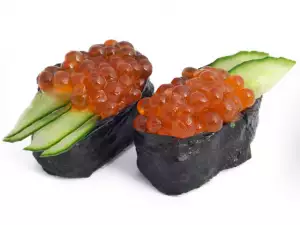
Benefits of caviar
Caviar is defined as one of the most nutritious products, with a superior calorific content to milk, meat, and many other foods. Caviar is rich in organic compounds essential to the human body. Research has shown that it helps to normalize blood pressure and increases our hemoglobin. Omega-3 and omega-6 polyunsaturated acids help improve brain function have a strong anti-allergic effect, improve blood circulation and reduce the risk of cardiovascular disease.
One can say that caviar is considered an aphrodisiac № 1, easily surpassing oysters, strawberries, chocolate, etc.
Recipes with caviar
Classic recipe for beaten caviar is made from:
Caviar - 3 tablespoons
oil - 400 ml
water - 150 ml, warm
Lemon S- juice of ½ A LEMON
onion -1 head blended, or shredded
Bread - 2-3 slices dry, no crust
The bread is crumbed and wet in a little hot water. Add the caviar and beat with blender. Gradually add 20-30 ml of oil in. After adding oil 3-4 times, pour some water over the oil. Finally, add the lemon juice and crushed onions. The caviar should be well matured.
The ingredients for the original tarama caviar are: 100-120 g pre- salted caviar, 500-700 ml oil and 1 piece of dry white bread, the juice of 1 lemon, 1/2 grated onion. Prepare tarama salad with 100 g white or red tarama, middle of 1 white bread (700 g), 50 ml olive oil 2 cloves garlic 1 onion, and the juice of 1 lemon. Optionally, you can add 1/2 kg boiled potatoes too.
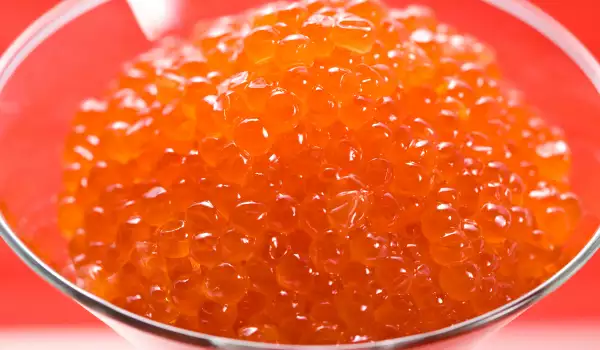

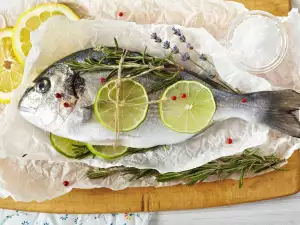

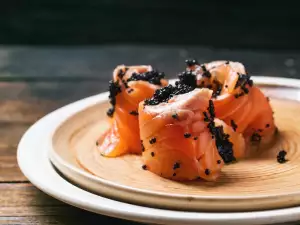
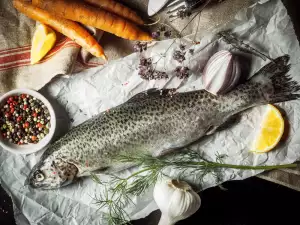
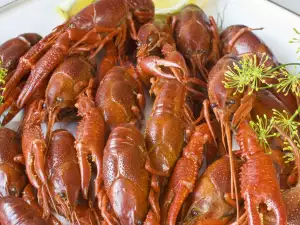
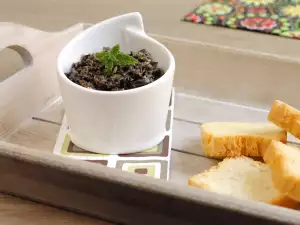
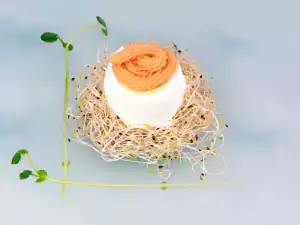
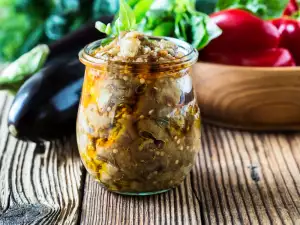
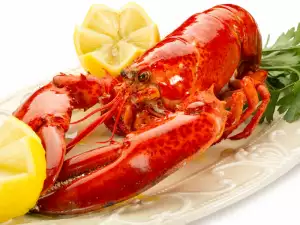

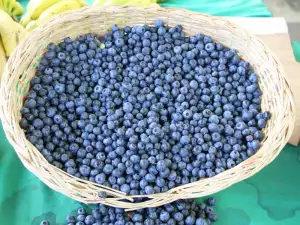

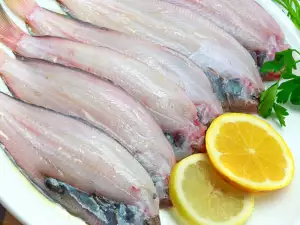




Comments